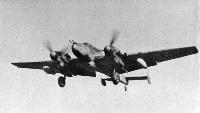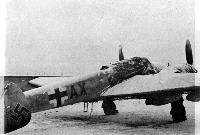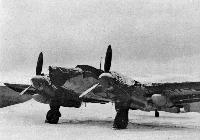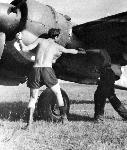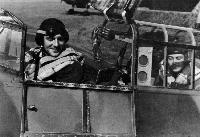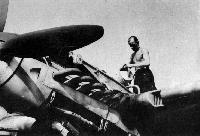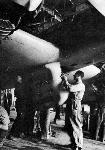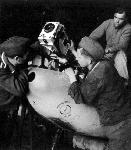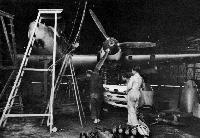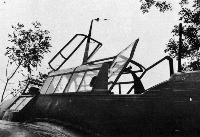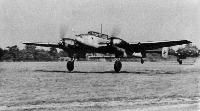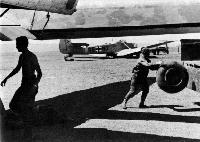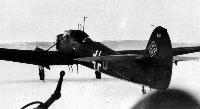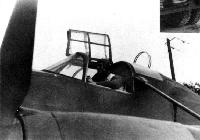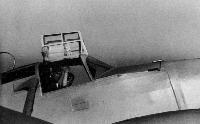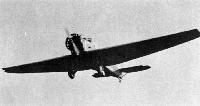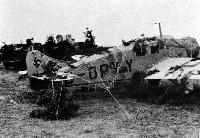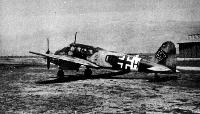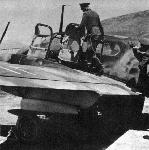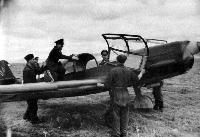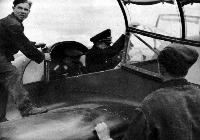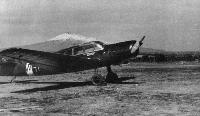Фотографии
-
As mechanics work on a Messerschmitt Bf 109E-3 in the foreground, Henschel Hs 123As of the 4th Staffel of Training Wing 1 wait on a grassy airfield during the Polish campaign of 1939. The typical segmented "splinter" camouflage pattern is clearly visible on all of the Hs 123s.
Самолёты на фотографии: Henschel Hs 123 - Германия - 1935Messerschmitt Bf.109E - Германия - 1938
-
The nose of a heavily armed Bf 110G, showing the barrels of the four MG 17 machineguns and the belly gun pack, containing twin MG151 20mm cannons.
Самолёты на фотографии: Messerschmitt Bf.110G - Германия - 1941
-
An excellent shot of a Bf 110G-2 heavy fighter carrying an additional belly gun pack with twin 30mm MK 108 cannons to double its internal nose armament of 2 more MK 108 cannons.
Самолёты на фотографии: Messerschmitt Bf.110G - Германия - 1941
-
Лишь одна эскадрилья Bf 110 действовала на северном, арктическом, участке советско-германского фронта. На снимке: Bf 110G (1В+АХ) из состава 13(Z)./JG 5, зима 1943-1944 годов.
Another view of the same Bf 110G covered from the elements. This view reveals that the aircraft's wings have also been covered. This is an aircraft of NJG5.Самолёты на фотографии: Messerschmitt Bf.110G - Германия - 1941
-
This Bf 110G of a night fighter squadron has been covered to protect it from the elements. The nose armament area, cockpit greenhouse and both engines have been covered.
Самолёты на фотографии: Messerschmitt Bf.110G - Германия - 1941
-
The ground crewman in the cockpit of this Hs 129B watches the sky overhead as a ground-attack version of the famous Focke-Wulf FW 190 sweeps over carrying two 100kg bombs under each wing and an additional 250kg bomb under the fuselage.
Самолёты на фотографии: Focke-Wulf FW.190F/G - Германия - 1942Henschel Hs 129 - Германия - 1939
-
Henschel Hs 129B-2 of 8/Sch.G. 2-8. Staffel Schlachtgeschwader 2
Самолёты на фотографии: Henschel Hs 129 - Германия - 1939
-
Crewmen prepare this Hs 129B-2/R3 for another mission. The B-2/R3 differed from the B-2/R2 in that it carried a 37mm BK3.7 cannon in its ventral pack and had no MG 17 armament in the lower troughs in the nose.
Самолёты на фотографии: Henschel Hs 129 - Германия - 1939
-
An Hs 129B-1/R2 ( Werk-Nr 141859) of 4./Sch.G.l photographed, probably at Mikoyanovka, during the summer of 1943. This unit, commanded by Oblt Dornemann, played an important role in Operation Zitadelle, being redesignated 10.(Pz)./SG 9 shortly thereafter.
This Hs 129B-2/R2 features the type of color scheme that was found on most Hs 129s. Uppersurfaces were painted in a splinter pattern of dark green and olive green, undersurfaces were in pale blue, and special markings included a yellow band around the rear fuselage to indicate that the aircraft was operating on the East Front, yellow wingtips on the undersurfaces indicating the same thing, and a yellow nose, indicating a ground support aircraft.Самолёты на фотографии: Henschel Hs 129 - Германия - 1939
-
A view of the lightweight warrior with a real knockout punch. In this photo, the peaceful, cloud-filled Russian sky hides well the fury it will behold later in the day.
Самолёты на фотографии: Henschel Hs 129 - Германия - 1939
-
A view of an Hs 129B without its ventral cannon pack. The internal armament consisted of 2 x 7.92mm MG 17s firing through the bottom troughs, while 2 x 20mm MG 151/20 cannon fired through the top troughs .
Самолёты на фотографии: Henschel Hs 129 - Германия - 1939
-
An impressive front view of a yellow-nosed Henschel. The yellow markings on the nose were used to identify the Hs 129 to friendly troops on the ground, as well as to friendly fighters in the air overhead.
Самолёты на фотографии: Henschel Hs 129 - Германия - 1939
-
Pilots of a Schlachtgeschwader discuss a mission on the tailplane of this Hs 129. The small holes in the vertical and horizontal control surfaces appear at first glance to be bullet holes but they are actually only the attachment points for braces that hold the moveable surfaces in place when the aircraft is not being used.
Самолёты на фотографии: Henschel Hs 129 - Германия - 1939
-
This pilot adjusts the chin strap of his flight helmet as he snuggles into the curved armored seat. The Revi C 12/C reflector gun sight was mounted outside of the cockpit canopy simply because there was not enough room for it inside. This proved to be a detriment in the cold Russian winters, because the reflector would ice over when the aircraft was in flight.
Самолёты на фотографии: Henschel Hs 129 - Германия - 1939
-
"К взлету готов!"
The pilot signals to the ground crew to stand clear as he starts the port engine. Visible behind the pilot's upraised left hand is the Revi reflector gun sight mounted in front of the armored windshield.Самолёты на фотографии: Henschel Hs 129 - Германия - 1939
-
Hauptmann Rudolf Ruffer, Staffelkapitan of 10 Staffel (Panzer), Schlachtgeschwader 9, in the armored cockpit of His Hs 129B-2/R3. Notice the leather-covered crash pad on the inside of the armored windshield. The windshield's armored glass was over one inch thick. As an Oberleutnant, Ruffer was awarded the Knight's cross of the Iron Cross after an engagement in which he single-handedly destroyed ten Soviet KV tanks that had broken through the German lines and were about to encircle and wipe out an infantry unit. When he landed after the mission, armorers found that his 30-round 30mm magazine still contained six rounds.
Самолёты на фотографии: Henschel Hs 129 - Германия - 1939
-
This pilot slides into the armored cockpit of his Hs 129B-2/R2 ground attack aircraft. Barely visible in the shadows below the forward fuselage is the 30mm MK 103 cannon.
Самолёты на фотографии: Henschel Hs 129 - Германия - 1939
-
A swarm of yellow-nosed Henschels sweeps low over an airfield after a successful tank-destroying mission in the Kursk salient during the summer of 1943.
Самолёты на фотографии: Henschel Hs 129 - Германия - 1939
-
Самолёты на фотографии: Henschel Hs 129 - Германия - 1939
-
Banking to the left, this Henschel prepares to swing into position with his wingman before diving on another enemy position below.
Самолёты на фотографии: Henschel Hs 129 - Германия - 1939
-
An Hs 129B-2/R2 flies low over the camera at a forward airfield. When equipped with a belly pack, the Hs 129 was not a speedy airplane, but this same lack of speed when coupled with the airplane's robust structure and a pilot with a good shooting eye, made the Hs 129 an extremely accurate shooting platform, and therefore a successful ground attack airplane.
Самолёты на фотографии: Henschel Hs 129 - Германия - 1939
-
An excellent shot of an Hs 129B-2/R3 with its belly pack containing a 37mm BK3.7 cannon. The airplane bears the markings of the Second Gruppe of the Schlachtgeschwader, a horizontal bar on the fuselage.
Самолёты на фотографии: Henschel Hs 129 - Германия - 1939
-
A Henschel Hs 129B warms up its twin Gnome-Rhone radial engines. The Hs 129B-1 was the standard production subtype and was armed with 2 x 20mm MG 151 cannon and 2 x 7.92mm MG 17 machine guns.
Самолёты на фотографии: Henschel Hs 129 - Германия - 1939
-
A Henschel banks to close up with the rest of the formation. She bears the yellow nose and fuselage band, as well as a white-outlined red "W" in front of the national insignia on the fuselage. A close look will reveal the two separate tones of green camouflage paint on her uppersurfaces.
Самолёты на фотографии: Henschel Hs 129 - Германия - 1939
-
Отметки на фонаре Hs 129 показывают возможные углы пикирования при атаке
With his canopy shut and both engines roaring, the pilot takes another look around before moving to the runway. The white lines on the side of the canopy aid the pilot in determining the angle of his dive by lining up the line desired with the horizon.Самолёты на фотографии: Henschel Hs 129 - Германия - 1939
-
The end of a successful mission. The grin on this pilot's face as he smooths back his hair indicates that he has destroyed at least one enemy armored vehicle.
Самолёты на фотографии: Henschel Hs 129 - Германия - 1939
-
This Henschel Hs 129B-2 sports an aerodynamic cover over the breech mechanism and belt feed guides of its 37mm anti-tank gun under the belly.
Самолёты на фотографии: Henschel Hs 129 - Германия - 1939
-
This Hs 129B is shown just prior to becoming airborne. The tailwheel is already off the ground and the pilot is applying left rudder to keep the aircraft on a steady course. This Henschel bears not only the Infantry Assault Badge on her nose, but also the insignia of the ground attack Staffel of Training Wing 2.
Самолёты на фотографии: Henschel Hs 129 - Германия - 1939
-
A Schlachtgeschwader pilot and a technical non-commissioned officer converse with the crew chief of this Hs 129B-2/R3. Barely visible in the photo is the barrel and muzzle brake of the 37mm BK3.7 cannon.
Самолёты на фотографии: Henschel Hs 129 - Германия - 1939
-
Armorers complete the loading of the ventral MK 103 cannon on this B-2/R2 of Schlachtgeschwader 1. The unique muzzle brake of the 30mm cannon helped to minimize the recoil when the high-velocity armor-piercing projectiles were fired.
Самолёты на фотографии: Henschel Hs 129 - Германия - 1939
-
Luftwaffe armorers work on the ammunition feed mechanism of the 30mm MK 103 cannon that has been swung down for better access. Note the 30mm projectiles hanging down from the breech area of the cannon on their disintegrating link fasteners. The box on the ground under the cannon holds the projectiles when the cannon is swung back up into the belly of the aircraft. The tips of the 30mm projectiles are color-coded to inform handlers of their function. The light-tipped projectiles are high explosive, while the ones with a single white band around the tips are armor-piercing.
Самолёты на фотографии: Henschel Hs 129 - Германия - 1939
-
Штурмовик Hs 129B-2 с 30-мм пушкой MK103 под фюзеляжем
A weatherbeaten Hs 129 bearing a 30mm MK 103 cannon pack guns its engines at the end of the runway. This aircraft belonged to the 4th Staffel of Schlachtgeschwader 1 and was used mainly as a tank-hunter; its 30mm projectiles were capable of penetrating the rear decking and engine covers of most Soviet tanks.Самолёты на фотографии: Henschel Hs 129 - Германия - 1939
-
A fine shot of an Hs 129B-2/R2 of Schlachtgeschwader 1 bearing the white-bordered black triangle that identified many ground support aircraft on the East Front. Also visible on the fuselage behind the cockpit is the squadron insignia of the 9th Staffel (ground attack) of Training Wing 2.
Самолёты на фотографии: Henschel Hs 129 - Германия - 1939
-
Here, an Hs 129B-2/R2 bearing a 30mm MK 103 cannon without its streamlined belly cover banks to the right. This aircraft is from the 9th Staffel (Panzer) of Schlachtgeschwader 1 and she shows three tank silhouettes on her rudder scoreboard.
Самолёты на фотографии: Henschel Hs 129 - Германия - 1939
-
Luftwaffe mechanics wind the inertia starter crank on the port engine of this Henschel. When sufficient speed was built up in the starter flywheel, the pilot engaged the clutch to start the engine.
Самолёты на фотографии: Henschel Hs 129 - Германия - 1939
-
Bf 110Cs of the "Haifischgeschwader" (shark wing), Zerstorergeschwader 76, occupy a forward airfield before the Polish campaign in the autumn of 1939. Other aircraft on the field include Junkers Ju 52 transports and one Ju 52 air ambulance, as well as He 111 bombers and several He 111s converted into transports for high-ranking Luftwaffe officials.
Самолёты на фотографии: Heinkel He-111 - Германия - 1935Junkers Ju.52/3m - Германия - 1931Messerschmitt Bf.110 - Германия - 1936
-
Henschel Hs 123A of 8/Sch.G 1 - 8. Staffel Schlachtgeschwader 1
Самолёты на фотографии: Henschel Hs 123 - Германия - 1935
-
An interesting photograph of a gaggle of Hs 123As circling over the battlefield like birds of prey, looking for new targets. Each aircraft had already dropped two of its four bombs and they are presumably ready to drop the other two.
Самолёты на фотографии: Henschel Hs 123 - Германия - 1935
-
On a cold winter morning, Luftwaffe armorers and ground crewmen bomb up a flight of Henschels on an ice-covered runway. The bombs on the ground are SC100s; 100 kg general purpose bombs. Notice the inadequate winter clothing worn by the ground crewmen; an indication that the supply situation was already bad at this point in 1942.
Самолёты на фотографии: Henschel Hs 123 - Германия - 1935
-
Ground crewmen ready this Henschel for another mission over the Soviet lines. She is shown loaded with four 50 kg general purpose SC50 bombs and her aerodynamic wheel covers have been discarded, exposing the gear struts and shock absorbers.
Самолёты на фотографии: Henschel Hs 123 - Германия - 1935
-
Hs 123As bearing the infantryman's assault badge on their fuselage sides await with full armament and fuel tanks for their pilots. The Infanterie-Sturmabzeichen was found on virtually all ground support aircraft as an indication of the unity between the pilots and their land-bound brothers.
Самолёты на фотографии: Henschel Hs 123 - Германия - 1935
-
A fine photograph of the BMW 132 660 horsepower radial engine of an HS 123. Note the NACA-style cowling that typified the Hs 123, with its streamlined fairings located over the valve covers of the 9-cylinder engine.
Самолёты на фотографии: Henschel Hs 123 - Германия - 1935
-
A classic in-flight photo of four Henschels of Schlachtgeschwader 1 on the East Front in 1942. All aircraft have the characteristic yellow bands around the fuselage that denoted aircraft of the East Front. The aircraft at the top of the photo is the only one of the group that has retained its streamlined landing gear spats and covers.
Самолёты на фотографии: Henschel Hs 123 - Германия - 1935
-
Messerschmitt Bf 110D-3 of 9 Gruppe ZG26
Самолёты на фотографии: Messerschmitt Bf.110 - Германия - 1936
-
This desert based Bf 110 carries a nose armament of 4 x 13mm MG 131 machine guns; a deviation from the standard armament of 4 x 7.92mm MG 17 machine guns.
Самолёты на фотографии: Messerschmitt Bf.110 - Германия - 1936
-
Ground crew and air crew take a break from the hot desert sun beneath the wing of this bombed up Bf 110 of Zerstorergeschwader 26.
Самолёты на фотографии: Messerschmitt Bf.110 - Германия - 1936
-
Here, a black-uniformed mechanic finishes loading the four MG 17 7.92mm machine guns in the nose of this Bf 110C. Note how the engines were covered with canvas to protect them all the time they were not in use.
Самолёты на фотографии: Messerschmitt Bf.110 - Германия - 1936
-
The twin ETC 250 bomb rack changed the standard Bf 110C fighter into the Bf 110C-4/B heavy fighter bomber. The Bf 110C-4/B proved to be quite effective as a fighter-bomber with 4 x MG 17 machine guns and 500kg of bombs.
Самолёты на фотографии: Messerschmitt Bf.110 - Германия - 1936
-
This crewman has just replaced the oil tank drain plug on the DB601F engine prior to filling the oil tank with fresh oil.
Самолёты на фотографии: Messerschmitt Bf.110 - Германия - 1936
-
The Group Adjutant of the II Gruppe of ZG76, a captain, is helped into his parachute by two members of the ground crew. The one piece flying suit was khaki in color and was also worn by bomber crew personnel as well.
Самолёты на фотографии: Messerschmitt Bf.110 - Германия - 1936
-
The pilot and his radioman/rear gunner look over a map of the area they will be flying over just prior to leaving on their mission. The aircraft is a Messerschmitt Bf 110C-1 heavy fighter.
Самолёты на фотографии: Messerschmitt Bf.110 - Германия - 1936
-
The two crewmen of this Bf 110 scramble up to the cockpit. Notice that the pilot is wearing a seat-pack parachute, similar to the kind worn by the pilots of single-engined fighters, while the rear gunner/radioman is wearing a standard back-pack parachute that was worn by most bomber crews. This is because the front seat of the Bf 110 had a deep bucket seat, making the use of a seat-pack necessary, while the cramped conditions and the folding back seat made the wearing of a back-pack parachute necessary in the rear cockpit.
Самолёты на фотографии: Messerschmitt Bf.110 - Германия - 1936
-
The adjutant of II Gruppe, ZG76 enters the cockpit of his Bf 110 heavy fighter. Barely visible in the rear cockpit is the rear gunner's single MG 15 machine gun with its ring sight.
Самолёты на фотографии: Messerschmitt Bf.110 - Германия - 1936
-
In this photo, the adjutant of II/ZG76 reaches for the canopy side panel in order to swing it up to its closed position. In an emergency, the top of the canopy, shown folded back, could be jettisoned to allow an easy exit of the pilot.
Самолёты на фотографии: Messerschmitt Bf.110 - Германия - 1936
-
Groundcrewmen assist the pilot of this Bf 110F into his aircraft. The insignia on the nose is that of the German night fighter arm, originally that of Nachtjagdgeschwader 1.
Самолёты на фотографии: Messerschmitt Bf.110 - Германия - 1936
-
This Bf 110C-4b of II/SKG 210 in faded winter camouflage bears the yellow fuselage band of most East Front aircraft and the unique wasp nose insignia of Zerstorergeschwader 1, the Wasp Wing.
Самолёты на фотографии: Messerschmitt Bf.110 - Германия - 1936
-
Bf 110D-3 из состава ZG 26 над Средиземным морем, лето 1941г. Под крылом - 900-л топливные баки
This photo shows a pair of Bf 110Cs carrying long-range drop tanks on escort duty over the Mediterranean in 1941. The aircraft in the foreground bears two insignia; the crowing rooster of the 9th Staffel of ZG26, and the June-bug of the III Gruppe of ZG26.Самолёты на фотографии: Messerschmitt Bf.110 - Германия - 1936
-
A fine View of a pair of Bf 110Cs of the first Staffel of Zerstorergeschwader 52 taken during the height of the Battle of Britain in late 1940. These aircraft were based in France.
Самолёты на фотографии: Messerschmitt Bf.110 - Германия - 1936
-
The pilot and rear gunner/radioman of this Bf 110 are wearing the typical small tinted-lens goggles that were worn by German aircrew members throughout the war. Another part of their flight gear is the cork-filled "sausage link" life jackets that were later supplanted by the inflatable type.
Самолёты на фотографии: Messerschmitt Bf.110 - Германия - 1936
-
A ground crewman tops up the oil in the oil tank of the big Daimler-Benz DB601 engine of this Bf 110. The Daimler-Benz DB601 engines of the Bf 110 put out a combined total of 2700 horse-power on takeoff.
Самолёты на фотографии: Messerschmitt Bf.110 - Германия - 1936
-
Here the armorers have succeeded in fitting one side of the large bomb rack. By pushing the rack upwards and flush with the belly of the aircraft, the armorers can insert the bolts into their lugs and secure the rack in place.
Самолёты на фотографии: Messerschmitt Bf.110 - Германия - 1936
-
Luftwaffe armorers replace the automatic gun camera between the MG 17 gun barrels in the nose of the Bf 110C. The hole in the nose is where the camera lens shows through and is quite visible in the photo.
Самолёты на фотографии: Messerschmitt Bf.110 - Германия - 1936
-
In this view, armorers carry a large paired ETC 250 bomb rack toward the waiting belly of this Bf 110, which has been placed on jacks for that purpose.
Самолёты на фотографии: Messerschmitt Bf.110 - Германия - 1936
-
Фонарь кабины экипажа с открытыми створками
The greenhouse of a Bf 110C, showing all of the moveable windows and hatches in their open positions. The squadron insignia under the pilot's forward cockpit shows that the aircraft is one belonging to the first Staffel of Zerstorergeschwader 2.Самолёты на фотографии: Messerschmitt Bf.110 - Германия - 1936
-
Bf 110C-1 из состава ZG 76 в боевой готовности накануне вторжения в Польшу 31 августа 1939 года
M8+DK, a Bf 110 of ZG76 in repose at a German airfield just prior to the opening of the 1940 campaigns that saw the Luftwaffe smash Belgium, Luxembourg, Holland, Denmark, Norway and France.Самолёты на фотографии: Messerschmitt Bf.110 - Германия - 1936
-
Bf 110Cs lift off a French airfield in September of 1940. Both aircraft are from Zerstorergeschwader 26, while the darker colored aircraft on the right wears the squadron insignia of the 5th Staffel of ZG26.
Самолёты на фотографии: Messerschmitt Bf.110 - Германия - 1936
-
An interesting shot of the pilot at his controls, taken from the radioman's seat in the rear. Note the auxiliary set of flight instruments; the artificial horizon, altimeter, airspeed indicator and chronometer.
Самолёты на фотографии: Messerschmitt Bf.110 - Германия - 1936
-
This Bf 110C experienced a rather hard landing on a desert airfield in Lybia. Luftwaffe ground personnel have already begun reclaiming the aircraft and her fuselage has been raised and held in place by the large stepladders so that the tail surfaces will not get damaged.
Самолёты на фотографии: Messerschmitt Bf.110 - Германия - 1936
-
Бытовая сцена на аэродроме: разгрузка планера Go-242 на фоне снесшего шасси Fw-58 (береговая эскадрилья "Крым")
Here, ground crewmen unload an aircraft tire as part of the cargo of this Gotha Go 242 transport glider as an FW 58 waits on its belly in the background with collapsed landing gear. The light grey-green RLM Grau paint scheme on the FW 58 was typical of many Luftwaffe multi-purpose aircraft.Самолёты на фотографии: Focke-Wulf FW.58 Weihe - Германия - 1935Gotha Go.242 - Германия - 1941
-
This view shows to advantage the glassed-in nose machine gun position and the fairing containing the bomb sight of this FW 58B. The Argus engine was capable of putting out 240 h.p. on takeoff.
Самолёты на фотографии: Focke-Wulf FW.58 Weihe - Германия - 1935
-
This FW 58 starts to taxi out across a frozen runway on a training flight. The plexiglass dome covering the dorsal machine gun turret was put in place only when this turret was not in use.
Самолёты на фотографии: Focke-Wulf FW.58 Weihe - Германия - 1935
-
An FW 58C throttles back for a landing at an advanced field on the East Front. One of the major distinguishing characteristics of the FW 58C was its solid nose, as opposed to the glassed-in nose of the FW 58B.
Самолёты на фотографии: Focke-Wulf FW.58 Weihe - Германия - 1935
-
Заправка Fw-58B на полевом аэродроме
A Luftwaffe refuelling crew tops up the fuel tanks on this FW 58B trainer. Note the rather dainty rearward-folding landing gear under the Argus As 10C air-cooled inverted vee engine.Самолёты на фотографии: Focke-Wulf FW.58 Weihe - Германия - 1935
-
A pilot-trainee takes the controls of this FW 58B instrument trainer. Visible on the fuselage behind the pilot is the circular radio direction-finding loop antenna; behind that, the antenna mast for the high frequency voice radio.
Самолёты на фотографии: Focke-Wulf FW.58 Weihe - Германия - 1935
-
Курсант и инструктор в кабине Fw-58C
The pilot and trainee in this light grey-green FW 58B trainer prepare to button up for a flight. Note the large support running between the fuselage side and the upper surface of the wing on this low winged monoplane. This particular aircraft was used as a transport for the personnel of Fighter Wing 54 on the East Front.Самолёты на фотографии: Focke-Wulf FW.58 Weihe - Германия - 1935
-
With brakes on and throttles all the way forward, this FW 58B builds up the RPMs in her twin Argus engines before the takeoff. The twin wire "clothesline" antennae are very obvious from this angle.
Самолёты на фотографии: Focke-Wulf FW.58 Weihe - Германия - 1935
-
A Ju(We) 34he approaches the landing strip. This view shows the similarity in design and construction that the Ju(We) 34 shared with its younger and more well-known 3-engined sister, the Ju 52 transport.
Самолёты на фотографии: Junkers W 33 / W 34 / Ju.46 - Германия - 1926
-
Регистрационный номер: D-OPYY Here, under liberal camouflage netting, stands a group of Junkers Ju(We) 34 instrument trainers bearing Luftwaffe markings of pre-WW II vintage. The Ju(We)34 was the predecessor to the FW 58 in virtually all fields of training. This bird was so docile and reliable that she was used all the way through the Second World War.
Самолёты на фотографии: Junkers W 33 / W 34 / Ju.46 - Германия - 1926
-
A nice view of the front quarter of an Fh 104. The unique national insignia on the nose of the airplane indicates that this is the personal transport of Field Marshal Kesselring, who is sitting in the pilot's seat.
Самолёты на фотографии: Siebel Fh.104 Hallore - Германия - 1937
-
This shot shows a Siebel Fh 104 transport with a unique tropical camouflage scheme. The original colors were a splinter pattern of dark green and olive green, but a sand yellow paint has been sprayed at random over the upper surfaces in large splotches to allow the aircraft to blend in better with its desert surroundings. The large white fuselage band indicates that this aircraft is operational in the Mediterranean theater of operations.
Самолёты на фотографии: Siebel Fh.104 Hallore - Германия - 1937
-
Wehrmacht officers on the wing of a Siebel Fh 104 twin-engined 5-place transport. This little Siebel gave the Messerschmitt Bf 108 much competition as a personal transport and liaison aircraft.
Самолёты на фотографии: Siebel Fh.104 Hallore - Германия - 1937
-
A Luftwaffe Bf 108B trainer shows off its aerodynamical iy clean lines. The leading edge slots can be seen on the left wing and the outward folding narrow track landing gear; characteristic of the Bf 108's big brother, the Bf 109 fighter.
Самолёты на фотографии: Messerschmitt Bf.108 Taifun - Германия - 1934
-
A Bf 108B trainer bearing pre-World War Two German civil AND military markings is prepared for a flight. The trademark "Messerschmitt Taifun" can be seen below the canopy on the side of the fuselage.
Самолёты на фотографии: Messerschmitt Bf.108 Taifun - Германия - 1934
-
In this view a high ranking Luftwaffe officer is helped up on to the wing of this Bf 108. These aircraft were highly coveted; many of them being used as personal transports by Generals.
Самолёты на фотографии: Messerschmitt Bf.108 Taifun - Германия - 1934
-
With one officer in back, another slides into the seat next to the pilot. Very obvious in this view are the open canopy sides that hinged against the windshield; closing to the rear in a clamshell manner.
Самолёты на фотографии: Messerschmitt Bf.108 Taifun - Германия - 1934
-
This Bf 108B is shown in an overall dark green colorscheme. The markings on the fuselage side and under the wings indicate that this is an aircraft that has been released from Air Ministry livery into the ranks of the Luftwaffe.
Самолёты на фотографии: Messerschmitt Bf.108 Taifun - Германия - 1934
Статьи
- Luftwaffe in Action 3 (3)


